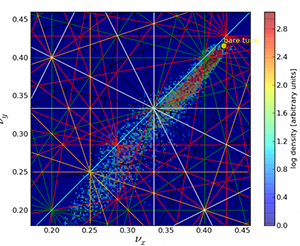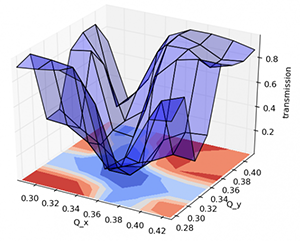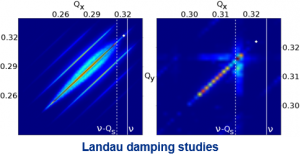Simulations of the Fermilab Main Injector
Increased intensity in the neutrino era could lead to unacceptable particle losses due to space charge and wakefield effects. Synergia simulations of the Main Injector are being used to understand the magnitude and characteristics of losses.
 Fermilab Main Injector
Fermilab Main Injector
Tune Space Survey

Main Injector Tune Transmission Efficiency
 The Main Injector transmission efficiency as a function of machine operating point (tune) showing the large efficiency drop near the third integer resonance. (Click for larger image)
The Main Injector transmission efficiency as a function of machine operating point (tune) showing the large efficiency drop near the third integer resonance. (Click for larger image)
Landau Damping Studies

(left) Betatron tune footprint for all particles in a model lattice operating at the coupling resonance. The largest proportion of particles are trapped on the diagonal resonance with smaller proportion on synchrobetatron resonance lines with tunes offset by multiples of the synchrotron tune above and below the diagonal. The yellow dot shows the bare betatron tune while the dashed line shows the tune the first depressed horizontal synchrotron mode. (Click for larger image)
(right) Betatron tune footprint for the 0.5% of particles from the left plot that gain or lose the most energy indicating damping. The largest proportion of these particles cluster along the diagonal, unlike classic Landau damping, where the damped particles would cluster around the first synchrobetatron mode. The coupling resonance interaction allows a newly recognized Landau damping interaction to occur. This was discovered and identified with Synergia simulations. (Click for larger image)
 The Main Injector transmission efficiency as a function of machine operating point (tune) showing the large efficiency drop near the third integer resonance. (Click for larger image)
The Main Injector transmission efficiency as a function of machine operating point (tune) showing the large efficiency drop near the third integer resonance. (Click for larger image)


